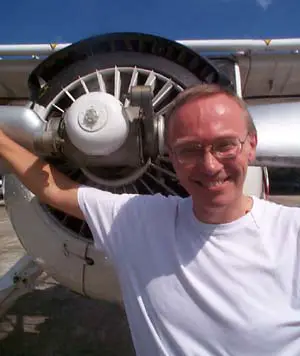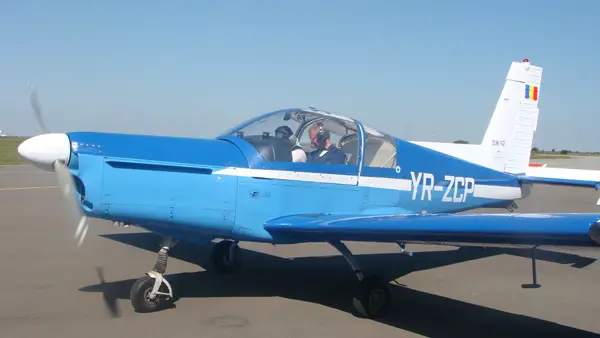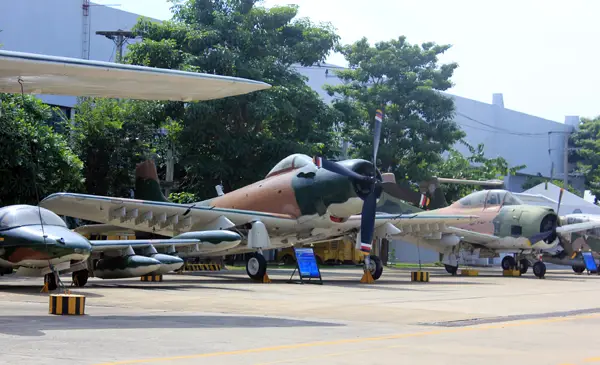Steve Darke is a 59-year-old British aircraft aficionado who, between 1993 and 1997, has spent four years in Thailand in the construction business. Although he returns frequently to Thailand, he is a resident of Romania and calls Arad his hometown. At the moment, he works as an engineering manager on a stadium for potential use in the forthcoming FIFA World Cup event in Doha, Qatar. Most importantly, he is also the man behind the Thai Aviation History website, the most comprehensive online project on this subject. In this interview, Steve talks about his love for airplanes and Thailand, as well as his future projects.
Voicu Mihnea Simandan: How and when has your passion for aviation started?
Steve Darke: Oh, since early childhood. I started, as most enthusiasts do, as a spotter in my early teens, then moved on to a private pilot license (PPL), and flying in my mid-20’s. As a serious aviation historian, really since I decided to record the history of Thai aviation, 20 years ago.
VMS: What is your background in aviation?
SD: As a hobby, I’m a private pilot, with a UK PPL issued in 1980, and have flown in many countries, including Thailand, Romania, Dubai, and Malaysia. But, unfortunately, I can’t make any money at that so, as a professional civil engineer, I have been working around the world in construction since the late 1970’s in increasingly senior positions. I have worked in UK (briefly), UAE, Qatar (twice), Saudi Arabia (twice), Thailand, India, Sri Lanka, Nigeria, Vietnam, Romania, Singapore, Malaysia and Borneo so far!
VMS: My hometown is also Arad…
SD: My Turkish wife and I came to Romania for work in 2008, and fell in love with the place.
VMS: What’s your connection with Thailand?
SD: Initially for work back in 1993. I was the Technical Manager on the construction of All Seasons Place on Wireless Road mainly. Never been before, and came from a spell in Malaysia. I have always had a passion for aviation and its history, and the longer I stayed the clearer it became that Thailand had an aviation history at least as rich as that of other countries, but that it had never been properly recorded outside the country. Local historians of course published in Thai, but their work was rarely to be found outside the country.
VMS: You have the most informative website in English on aviation in Thailand. How did you start it?
SD: I got to know a lot of people in the Thai aviation industry, civil and military, and started to collect information. I gained access to the archives of the Department of Aviation, and later some military archives. I photographed every aeroplane I came across, and found that even the military were very open if you approached them in the right way. After several years I was not sure what to do with this information so, around 2001, I set up a website and also a Yahoo Group to bring together like-minded enthusiasts. Since then my website has grown from a couple of pages to an extensive database and with thousands of photos. The monthly page views are around 7,000 – 8,000.
VMS: Tell me more about the Yahoo Group.
SD: In 2001, I started the ‘Apichart’ Yahoo Group (former ‘Smartgroup’ – which is now defunct). We have 37 members, all are active. Messages are between 50 and 100 per month. By invitation only.
Here is the description on the home page: “The group was ‘founded’ in 2001 by a number of aviation enthusiasts / historians who came together whilst researching the history of a Curtiss C-46 Commando used in Bangkok as the Apichart Coffee Shop, hence the name of the club. The purpose of this group is to act as a forum between members for the discussion of South-East Asian aviation-related issues, both historical and current. The group covers such activities throughout SE Asia, including Thailand, Malaysia, Singapore, Laos, Cambodia, Vietnam, Indonesia, Philippines, Brunei, Burma etc. Specifically excluded are China, Japan and HK (which are well covered by other groups).”
VMS: How would you assess the situation of civil and military aviation in Thailand compared to its Southeast Asian neighbours?
SD: The background is completely different from that in any of Thailand’s neighbours because of the unique political history of the country. Thailand has remained basically a free (some may dispute this) and prosperous country with probably one of the biggest tourist industries of any similarly sized country. Numbers of Chinese and Korean visitors are increasing at amazing rates.
Bangkok has become a hub for travel in the whole region, overtaking Singapore which had 51.2 million passengers in 2012. Suvarnabhumi Airport has already, only 6 years after opening, reached its design capacity, hence the need to re-open Don Mueang. There are a never-ending stream of start-up airlines, some of whom make it and some who don’t. A very lively market since regulations were relaxed a few years ago.
Militarily, Thailand seems to have a policy of wanting a couple of everything! They seem to buy on the whim of whoever makes the decision. A couple of Russian helicopters here, then a small fleet of Enstroms, then back to Eurocopter, etc, etc. They bought an aircraft carrier, and a fleet of ex-Spanish Harriers to operate from it, but that only lasted a few years. Nevertheless, they have a very effective fighter force with F-16’s and Gripens, all of which are essentially active (unlike the fighter fleets in other countries of which only a small percent are active at any one time). I don’t know the strength of the neighbouring countries, but I’m sure Thailand has at least equivalent strength. They also co-operate closely with Singapore and the US – the recent ‘Cope Tiger’ exercises at Korat are an example.
 VMS: Is there a need for aviation in Thailand to modernize?
VMS: Is there a need for aviation in Thailand to modernize?
SD: Not in any real way. They already have up-to-date fleets and policies. An exception would be the national carrier, THAI, which is still seen as a bit of a dinosaur, but even they have spun-off some of their routes to more dynamic subsidiaries like Nok Air and Thai Smile. Thai AirAsia, part of the much bigger AirAsia group, are as efficient as you will get. Bangkok Airways have found a good niche market. There is still a place for small operators like SGA (who operate as Nok Mini).
Militarily I can’t comment on their organization, but the only really ageing fleets are the general purpose helicopters of both Army and Air Force. The Hercules transport fleet will probably need to be replaced before too much longer, but they do good service.
VMS: Are there many civilian/amateur pilots (foreigners or Thai) in Thailand who pursue aviation as a hobby?
SD: Yes and yes. There are two or three active flying clubs in Thailand, but regulations for private flying are becoming stricter.
The Thai Flying Club is based at Bangphra, between Bangkok and Pattaya, and was the first civilian club formed 30 years ago. In the last couple of years the airfield at Tantawan (20km or so north of Saraburi) has become very active, and is probably the most active GA field at present. There is also an active club, Nok, up near Chiang Mai; they are the only place in Thailand which offers gliding. Also a club at Pattaya Air Park, but unfortunately the owner and driving force was killed in January, so its future is uncertain.
VMS: Is it an expensive hobby?
SD: Yes, expensive. A Cessna 172 will cost 4800 Baht (around €125) plus fuel an hour. I pay half that in Romania!
VMS: Where would someone interested in flying in Thailand have to start?
SD: My first choice as of today would be Tantawan. Very active and vibrant club. The Thai Flying Club at Bangphra is a bit stale and stagnant now.
VMS: You have an archive of over 3300 photos with planes found in Thailand, most with full descriptions of type and ownership. Where and how did you get your information? Who are your collaborators?
SD: About half the photos are my own, taken over the past 20 years. Other than that I have a whole team of unofficial contributors, both resident in Thailand and visitors. My site gives them a forum on which to post their photos, and allows me to build up as complete a record as possible.
The information to caption the photos comes from the Thai aircraft register and is based on official data from the Thai DCA, to whom many thanks, plus a lot of reports from enthusiasts. I also have a large team of correspondents who each specialize in different aspects of aviation history, and who can add details. For example, an enthusiast may specialize in data on Eurocopter helicopters and will be able to provide additional data from that side. I also get a lot of data directly from airlines and other operators with whom I have a good relationship.
VMS: Your website has the register for Cambodian, Laos and Romanian aircraft. How did you come to compile these?
SD: Cambodia and Laos is more difficult because official data is hard to find, but again mainly from reports, photos from enthusiasts, data from aircraft manufacturers and operators.
In Romania, as with Thailand, I could find no comprehensive database anywhere else. The data is from both official sources and enthusiasts.
VMS: What places of interest are there in Thailand for someone interested in aviation?
SD: One of the main places to visit would be the Royal Thai Air Force Museum at Don Mueang. This is a long-established museum, which opened to the public in 1969. It has a large collection of aircraft (about 90), many unique. It is free and open most days.
Jesada Technik Museum at Nakhon Chaisi is well worth a visit, with a good collection of aircraft (and of cars, buses etc).
More difficult to access, requiring prior permission, are the collections of Tango Squadron (in full ‘Foundation For The Preservation and Development of Thai Aircraft’) at Don Mueang and Chiang Mai. This is essentially a private collection.
There are other smaller collections around, such as the Bangkok Science Center on Sukhumvit.
Every year on Children’s Day (2nd Saturday of January) many military bases put on airshows and are open for visitors. The main display is at Don Mueang.
VMS: In April 2011, your website received the “Top Aviation Website Award” from Best Aviation Sites. What are your future plans for the website?
SD: As to the future it depends on time. I update something most days and have no plans for a major revamp yet. Next I will probably try to find a way of giving easier access to photos from direct links.
I am also looking at some unobtrusive advertising. I have had several approaches, but all so far have either required quite annoying large ads, or were for things completely irrelevant to the site.
VMS: You are also working on a book about aviation in Thailand. I know of just one more book dealing with the history of Thai aviation, written Edward M. Young — Aerial Nationalism: A History of Aviation in Thailand — and published by the Smithsonian History of Aviation in 1994. Are there any other books on this topic?
SD: Ed Young’s book is very good. I’ve met him. His father was Ambassador or just below, in Thailand in the 60’s so he spent his childhood in Thailand. His book is indeed the only original book in English; a couple of others (eg The History of Aviation in Thailand – Lumholdt & Warren – 1987) have just para-phrased Ed’s work. Ed’s book covers the whole period from 1913, but concentrates mainly on military.
VMS: How about your book?
SD: As to my book, written in collaboration with Dr. Virachai Vannukul, it has the working title of Royal Orchid: The Anatomy of Civil Aviation in Thailand. In it I cover only civil aviation in Thailand since WW2, but in great detail. The book is scheduled to be at the printers about June 2013. I won’t mention the publishing house as yet, but we are in the layout stage at the moment.
VMS: I’m looking forward to reading your book and meeting you, either in Bangkok or Arad.
March 18, 2013
Voicu Mihnea Simandan
Bangkok, Thailand



